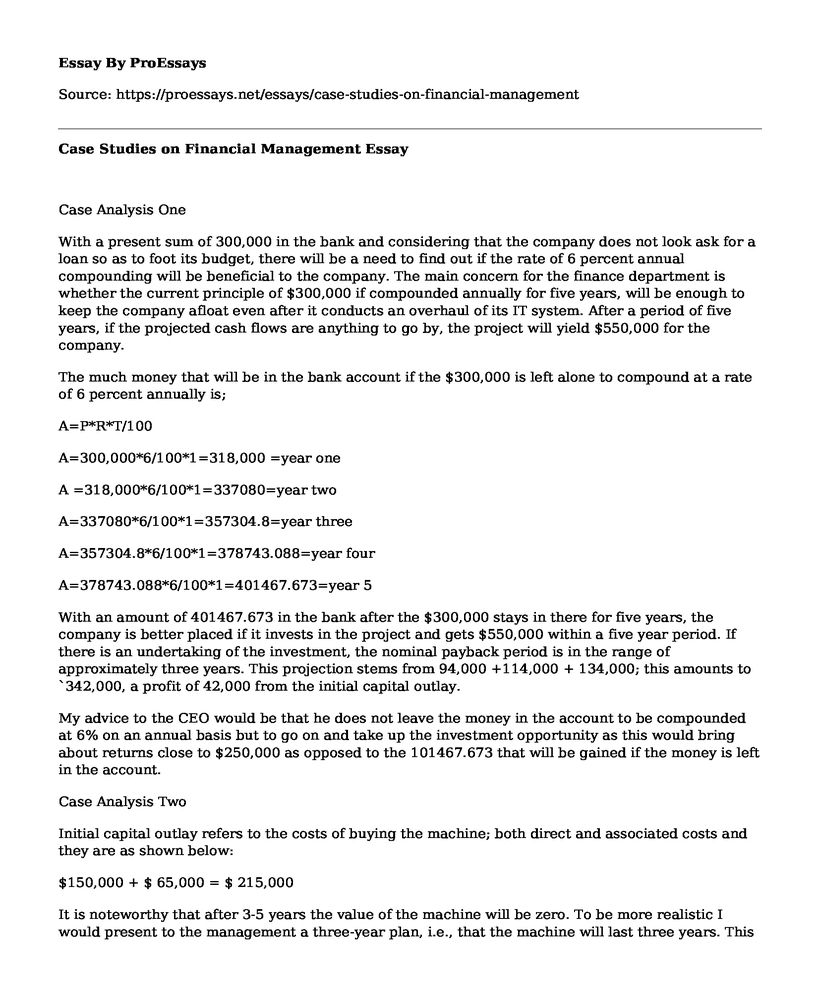Case Analysis One
With a present sum of 300,000 in the bank and considering that the company does not look ask for a loan so as to foot its budget, there will be a need to find out if the rate of 6 percent annual compounding will be beneficial to the company. The main concern for the finance department is whether the current principle of $300,000 if compounded annually for five years, will be enough to keep the company afloat even after it conducts an overhaul of its IT system. After a period of five years, if the projected cash flows are anything to go by, the project will yield $550,000 for the company.
The much money that will be in the bank account if the $300,000 is left alone to compound at a rate of 6 percent annually is;
A=P*R*T/100
A=300,000*6/100*1=318,000 =year one
A =318,000*6/100*1=337080=year two
A=337080*6/100*1=357304.8=year three
A=357304.8*6/100*1=378743.088=year four
A=378743.088*6/100*1=401467.673=year 5
With an amount of 401467.673 in the bank after the $300,000 stays in there for five years, the company is better placed if it invests in the project and gets $550,000 within a five year period. If there is an undertaking of the investment, the nominal payback period is in the range of approximately three years. This projection stems from 94,000 +114,000 + 134,000; this amounts to `342,000, a profit of 42,000 from the initial capital outlay.
My advice to the CEO would be that he does not leave the money in the account to be compounded at 6% on an annual basis but to go on and take up the investment opportunity as this would bring about returns close to $250,000 as opposed to the 101467.673 that will be gained if the money is left in the account.
Case Analysis Two
Initial capital outlay refers to the costs of buying the machine; both direct and associated costs and they are as shown below:
$150,000 + $ 65,000 = $ 215,000
It is noteworthy that after 3-5 years the value of the machine will be zero. To be more realistic I would present to the management a three-year plan, i.e., that the machine will last three years. This would be according to Carla's belief that the machine would last for three years. What's more, it is much more appropriate if Carlas higher discount rate is used due to the risk of this type of project. The person whose scenario is most aggressive is Danny because a lower discount rate of 10% and a higher expectation of the life of the machine will be five years as opposed to three years is very much of a gamble. Beyond financial measures, the things that I would want to consider is whether the company will eke more value from the machine or if the company would still produce high-quality products for customers without a need for the machine.
Case Analysis Three
There is no knowing as to whether the new law firm will be lucrative or not lucrative save for what the totality of the benefit streams after tax will show.
The initial capital outlay that will be required to establish and publicize the firm is $200,000 + $60,000 + $20,000 + $20,000 + $275,000 + $50,000 = $ 625,000
The after tax net income from operations include
- 103,500 - 50,500 + 36,700 + $63,400 + $81,500 + $92,700 + $102,600 + $119,500 = 342,400
The after tax cash flow from operations include
- 85,600 + $15,000 + $48,600 + $72,200 + $95,550 + $101,300 + $125,200 + $140,200= $512, 450
The terminal value of the new venture after taxes and deductions ie the price with which the new venture could be sold is $300,000
From a purely financial perspective I would not recommend this purchase to the management because the initial capital outlay is approximately twice the terminal value. In addition to that, the after tax net income from operations and the after tax cash flow from operations of the 8 year period within which the company will be in operation do not match the initial capital outlay.
The nonfinancial elements of this proposal that need to be considered include the amount of time it will take for this junior law firm to be a preference for customers and the effort that will be put in to develop said law firm. As such, legal clinics cannot be compared to fast-moving consumer goods, and this makes the projections to be pretty much just projections.
For this to be a bad investment, the things that would have to be true include the fact that consumers will not respond positively to the establishment, the establishment may not be able to foot its bills and may be heavily dependent on the parent company to help cover its bills, and finally the venture may drive the parent company bankrupt.
If I were the CEO, I would not approve of this proposal because projections alone are not a surefire way of telling that a particular investment will prove to be super lucrative.
Cite this page
Case Studies on Financial Management. (2021, Jun 23). Retrieved from https://proessays.net/essays/case-studies-on-financial-management
If you are the original author of this essay and no longer wish to have it published on the ProEssays website, please click below to request its removal:
- Leader Rewards and Punishment Behavior Essay
- Leadership Approaches and Organizational Change Paper Example
- Teamwork Development Paper Example
- Comparing Stalin and Hitler: Similarities and Differences in Leadership - Essay Sample
- Essay Example on Exploring the Fast-Food Industry: From 1921 to Today
- Essay Example on Allison Elam's Idea: New MRP System or Costly Catastrophe?
- The Leadership Styles Survey and the Enneagram - Paper Example







